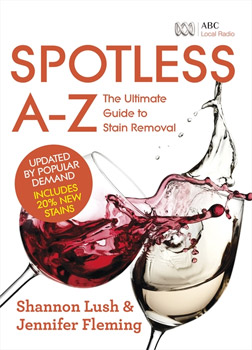Spotless A-Z

Spotless A-Z
When Shannon Lush and Jennifer Fleming published Spotless in 2005 it became an instant bestseller. Today over half a million Australian households rely on the pair's books when disaster strikes. But Australians are confronting an ever-increasing range of stains today and now in Spotless A-Z those stains are tackled for the first time.
Whether it's beetroot or burn marks, mud or mulberries, grass stains or glue, kebabs or kiwi fruit, whether it's on clothing, upholstery, timber, leather or concrete – the solutions are at your fingertips in Spotless A-Z.
Organised in a handy A-Z format – by popular request – Spotless A-Z offers what Google won't – tried and true, low toxic, effective stain removal techniques for when you can't afford to make a mistake. The comprehensive A-Z format enables you to find solutions to stains easily and efficiently, which is especially useful when you need to act quickly. There is no need to consult an index – just turn to P for paint or W for wine and you will find what you are looking for. There's even an entry for -mystery stains' to help you work out what to do if you don't know what the stain is!
No home should be without Spotless A-Z.
Shannon Lush is a fine arts restorer who for the past decade has been solving domestic disasters through regular appearances on radio, TV and in print. She's never been stumped by a -how-to' question.
Jennifer Fleming is a long-time presenter and producer at ABC Radio working across a range of popular programs. Together they are creators of the bestselling Spotless series of books.
Spotless A-Z
HarperCollins Australia
Authors: Shannon Lush and Jennifer Fleming
ISBN: 9780733333408
RRP: $19.99
Interview with Shannon Lush and Jennifer Fleming
Question: What new stains have been added to Spotless A-Z?
Shannon Lush and Jennifer Fleming: New stains include pomegranate, hoisin sauce and tandoori sauce. It's items people use more of these days, rather than being totally new stains. There's hummus, black bean sauce and saffron. We've tried to imagine every stain possible.
Question: What are the main products/ingredients needed to tackle the majority of stains?
Shannon Lush and Jennifer Fleming: Stain removal involves basic chemistry. The most used ingredients are bicarb, which is an alkali, and white vinegar, which is an acid. Mix the two together and you get a great cleaning reaction. Another great cleaner is a cake of bathroom soap and water. Dishwashing liquid also comes in handy to remove fat stains. Sunshine is also a great cleaner. They're low cost, low toxic and do a great job.
Question: Can you tell us about the -mystery stains' section – what's the first thing we should do?
Shannon Lush and Jennifer Fleming: The first thing to do with a mystery stain is not to panic and use a product that makes the stain worse. Look and feel the stain first. We have tips in the book to diagnose mystery stains. If in doubt, do a test patch first. You can use a cotton bud with various solvents to see which works. Also, use cold water first. If you use hot water, you can set protein stains. The main stains are proteins, carbohydrates, fats/oils, pigments and resins. Once you work out what the stain us, apply the solution.
Question: How many times have tests been conducted on the solutions found in Spotless A-Z?
Shannon Lush and Jennifer Fleming: Many of the solutions in Spotless A-Z have been passed down from generation to generation. I always need to know why something works and constantly test new stain removal techniques. If it doesn't work well enough, it doesn't go into the books. I've even discovered solutions accidentally, such as the time when I spilled tea over aluminium and discovered tannic acid (a constituent of tea) cleans aluminium oxide beautifully. I'm a fine arts restorer by trade and have intimate knowledge of how different mediums work together.
Question: Can you provide your tips for cleaning stainless steel?
Shannon Lush and Jennifer Fleming: The best way to clean stainless steel is with a pair of pantyhose and water. The weave of the pantyhose is ideal for this surface. If the surface is very dirty, use bicarb and white vinegar on pantyhose.
MORE



